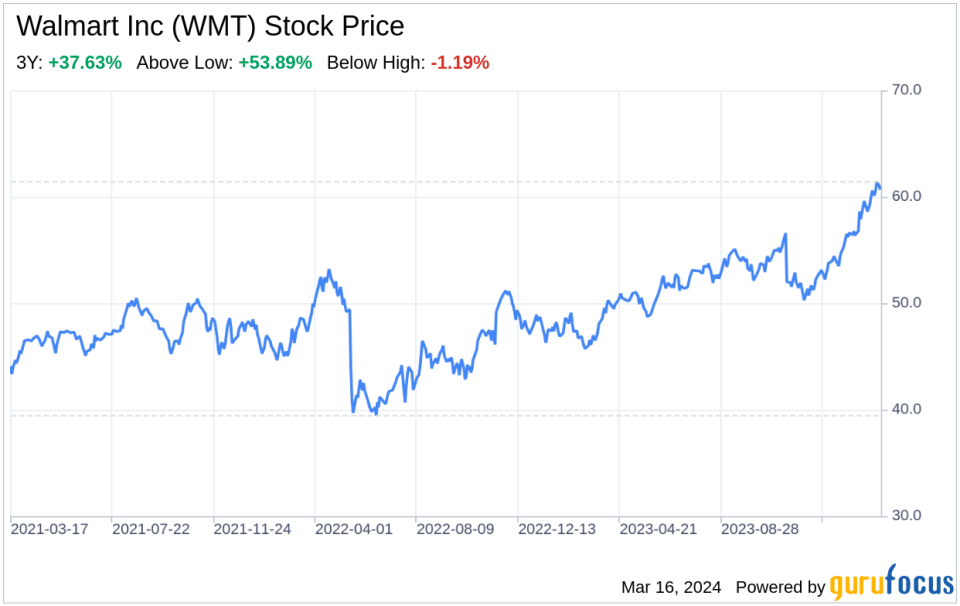Decoding Walmart Inc (WMT): A Strategic SWOT Insight
Walmart Inc (NYSE:WMT) showcases robust financial growth with net sales reaching $642.6 billion in fiscal 2024.
Strategic omni-channel initiatives and a strong brand presence underpin Walmart's market dominance.
Competitive pressures and evolving consumer behaviors present ongoing challenges for the retail behemoth.
Walmart's commitment to sustainability and community engagement strengthens its corporate reputation.
On March 15, 2024, Walmart Inc (NYSE:WMT), the leading retailer in the United States, released its 10-K filing, revealing a comprehensive financial performance for the fiscal year ended January 31, 2024. The company reported a significant increase in net sales, climbing to $642.6 billion, up from $605.9 billion in the previous year. This growth is a testament to Walmart's enduring appeal to consumers and its ability to maintain a competitive edge in the retail market. The company's operating income also saw a notable rise to $27 billion, reflecting its operational efficiency and strategic cost management. With a consolidated net income of $16.3 billion, Walmart continues to demonstrate its financial resilience and capacity for sustained profitability. As we delve into a SWOT analysis of Walmart Inc, these financial highlights provide a solid foundation for understanding the company's strategic position and future outlook.

Strengths
Market Leadership and Brand Equity: Walmart Inc's formidable market presence is a cornerstone of its strength. With net sales exceeding $642 billion in fiscal 2024, the company's scale and reach are unparalleled in the retail sector. Walmart's brand is synonymous with value and convenience, attracting a broad customer base and fostering loyalty. The company's pricing philosophy, Everyday Low Prices (EDLP), and its commitment to cost savings, Everyday Low Cost (EDLC), have cemented its reputation as a price leader, earning customer trust and driving consistent traffic to both its physical stores and digital platforms.
Omni-channel Retail Strategy: Walmart's strategic investments in eCommerce and technology have fortified its omni-channel retail approach, seamlessly integrating online and in-store experiences. Initiatives such as same-day pickup and delivery, Walmart+, and the expansion of its digital advertising and fulfillment services have enhanced customer convenience and satisfaction. The company's ability to leverage its vast network of stores for online order fulfillment has not only improved efficiency but also positioned Walmart at the forefront of retail innovation.
Financial Health: The company's strong balance sheet, with a consolidated net income attributable to Walmart of $15.5 billion, underscores its financial health. Walmart's ability to generate substantial cash flows enables it to invest in growth initiatives, pay dividends, and execute share repurchases, further solidifying its market position and shareholder value.
Weaknesses
Dependence on the US Market: Despite its global presence, Walmart's financial performance is heavily reliant on the US market, which generated over $440 billion in domestic sales in fiscal 2024. This dependence on a single geographic region could expose the company to risks associated with economic downturns, regulatory changes, and competitive dynamics specific to the US market.
Operational Challenges in International Markets: Walmart's international operations, while contributing $115 billion in sales, face unique challenges, including currency volatility, local competition, and regulatory hurdles. The complexity of managing a diverse global portfolio can strain resources and divert focus from core markets, potentially impacting overall profitability.
Workforce Management: With a workforce of approximately 2.1 million associates globally, Walmart must navigate the intricacies of labor relations, wage pressures, and employee retention. The company's workforce strategy aims to foster a culture of belonging and growth, but the sheer scale of its employment base presents ongoing challenges in human capital management.
Opportunities
Expansion of Digital and Service Offerings: Walmart has the opportunity to further grow its digital footprint and service offerings, such as Walmart Connect, Walmart Fulfillment Services, and Walmart GoLocal. By capitalizing on its ecosystem, Walmart can diversify revenue streams and deepen customer engagement, leveraging technology to stay ahead of consumer trends and preferences.
Strategic Alliances and Acquisitions: The company's financial strength positions it well to pursue strategic alliances and acquisitions that can enhance its market offerings and drive innovation. Partnerships, like the fintech venture ONE and the healthcare initiative with UnitedHealth Group, can open new avenues for growth and customer acquisition.
Global Market Penetration: Walmart's international segment presents significant opportunities for expansion, especially in emerging markets with growing middle-class populations. By tailoring its business model to local needs and leveraging its global supply chain, Walmart can capture additional market share and diversify its geographic revenue base.
Threats
Intense Competition: The retail landscape is highly competitive, with players ranging from traditional brick-and-mortar stores to eCommerce giants and omni-channel retailers. Walmart must continually innovate and adapt to maintain its competitive edge, as rivals may offer more favorable terms, greater brand recognition, or more advanced digital capabilities.
Economic and Geopolitical Uncertainties: Macroeconomic factors such as interest rates, energy costs, and currency fluctuations can impact consumer spending and Walmart's operational costs. Geopolitical tensions and trade barriers can also affect the company's global supply chain and market access, potentially disrupting its business model.
Regulatory and Legal Risks: Walmart operates in a complex regulatory environment and faces potential legal challenges that can result in financial penalties or reputational damage. Compliance with evolving regulations, particularly in areas like labor laws, data privacy, and environmental standards, requires vigilance and adaptability.
In conclusion, Walmart Inc (NYSE:WMT) stands
This article, generated by GuruFocus, is designed to provide general insights and is not tailored financial advice. Our commentary is rooted in historical data and analyst projections, utilizing an impartial methodology, and is not intended to serve as specific investment guidance. It does not formulate a recommendation to purchase or divest any stock and does not consider individual investment objectives or financial circumstances. Our objective is to deliver long-term, fundamental data-driven analysis. Be aware that our analysis might not incorporate the most recent, price-sensitive company announcements or qualitative information. GuruFocus holds no position in the stocks mentioned herein.
This article first appeared on GuruFocus.
